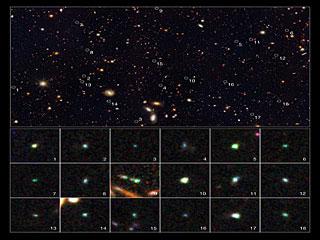
Tiny galaxies brimming with star birth. Photo: ESA Hubble.
WASHINGTON (BNS): Hubble Space Telescope has uncovered an extraordinary population of tiny, young galaxies that are brimming with star formation in early universe, according to a report.
The galaxies are churning out stars at such a rate that the number of stars in them would double in just ten million years. For comparison, the Milky Way has taken a thousand times longer to double its stellar population.
According to Hubble, these newly discovered dwarf galaxies are around a hundred times smaller than the Milky Way. Their star formation rates are extremely high, even for the young Universe, when most galaxies were forming stars at higher rates than they are today. They have turned up in the Hubble images because the radiation from young, hot stars has caused the oxygen in the gas surrounding them to light up like a fluorescent sign.
Astronomers believe this rapid star birth represents an important phase in the formation of dwarf galaxies, the most common galaxy type in the cosmos.
The observations were part of the Cosmic Assembly Near-infrared Deep Extragalactic Legacy Survey (CANDELS), an ambitious three-year survey to analyse the most distant galaxies in the Universe. CANDELS is the first census of dwarf galaxies at such an early epoch on the Universes history.
The observations of ancient galaxies are somewhat at odds with recent detailed studies of the dwarf galaxies that are currently orbiting the Milky Way.
Overall 69 young dwarf galaxies in near-infrared images were taken with Hubble's Wide Field Camera 3 and Advanced Camera for Surveys by the CANDELS team.
The observations concentrated on two regions of the sky called the Great Observatories Origins Deep Survey-South and the UKIDSS Ultra Deep Survey (part of the UKIRT Infrared Deep Sky Survey).
According to the observation details, the newly discovered galaxies were very common nine billion years ago. But it is a mystery why the newly found dwarf galaxies were making batches of stars at such a high rate. Computer simulations show that star formation in small galaxies may be episodic. Gas cools and collapses to form stars. The stars then reheat the gas through, for example, supernova explosions, which blow the gas away. After some time, the gas cools and collapses again, producing a new burst of star formation, continuing the cycle.
 Previous Article
Previous Article Next Article
Next Article











The Indian Air Force, in its flight trials evaluation report submitted before the Defence Ministry l..
view articleAn insight into the Medium Multi-Role Combat Aircraft competition...
view articleSky enthusiasts can now spot the International Space Station (ISS) commanded by Indian-American astr..
view article